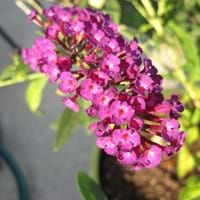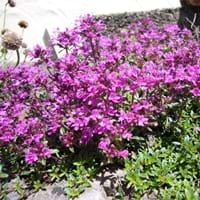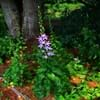Life Span
Perennial
Perennial
Type
Flowering Plants, Shrubs
Herbs
Origin
Africa, America, Asia
Europe, Mediterranean
Types
Lockinch, Petite Indigo, White Profusion
Not Available
Habitat
Along Railroads, River side, Roadsides
Sandy areas, Stony hillsides, Upland soils
USDA Hardiness Zone
5-10
Not Available
Sunset Zone
H1, 2a, 2b, 3a, 3b, 4, 5, 6, 7, 8, 9, 10, 11, 12, 13, 14, 15, 16, 17, 18, 19, 20, 21, 22, 23, 24
A2, A3, 1a, 1b, 2a, 2b, 3a, 3b, 4, 5, 6, 7, 8, 9, 10, 11, 12, 13, 14, 15, 16, 17, 18, 19, 20, 21, 22, 23, 24
Habit
Arching/Fountain-shaped
Mat-forming
Minimum Height
Not Available
Minimum Width
Not Available
Flower Color
Blue, Pink, Purple, Red, White
Purple, Light Pink
Flower Color Modifier
Not Available
Bicolor
Fruit Color
Not Available
Not Available
Leaf Color in Spring
Gray Green
Green
Leaf Color in Summer
Gray Green, Light Green
Green
Leaf Color in Fall
Gray Green, Light Green, Yellow green
Green
Leaf Color in Winter
Not Available
Light Green
Leaf Shape
Egg-shaped
Oval
Plant Season
Fall, Spring, Summer, Winter
Spring, Summer, Fall, Winter
Sunlight
Full Sun, Part sun, Partial shade
Full Sun, Partial Sun
Type of Soil
Loamy, Sandy, Well drained
Sand
The pH of Soil
Neutral, Slightly Acidic, Slightly Alkaline
Neutral, Alkaline
Soil Drainage
Well drained
Well drained
Tolerances
Drought, Pollution, Salt, Soil Compaction
Drought
Where to Plant?
Ground, Pot
Container, Ground
How to Plant?
Seedlings, Stem Planting, Transplanting
Divison, Seedlings
Plant Maintenance
Medium
Medium
Watering Requirements
Form a Soil ring to water efficiently, Water Deeply, Water twice a day in the initial period
Average Water Needs
In Summer
Lots of watering
Lots of watering
In Spring
Moderate
Moderate
In Winter
Average Water
Average Water
Soil pH
Neutral, Slightly Acidic, Slightly Alkaline
Neutral, Alkaline
Soil Type
Loamy, Sandy, Well drained
Sand
Soil Drainage Capacity
Well drained
Well drained
Sun Exposure
Full Sun, Part sun, Partial shade
Full Sun, Partial Sun
Pruning
Cut or pinch the stems, Prune for shortening long shoots, Prune if you want to improve plant shape, Prune ocassionally, Remove damaged leaves, Remove dead or diseased plant parts, Remove deadheads, Remove shoots
Remove damaged leaves, Remove dead branches, Remove dead leaves
Fertilizers
All-Purpose Liquid Fertilizer
All-Purpose Liquid Fertilizer
Pests and Diseases
Downy mildew, Leaf spot, Spider mites
Not Available
Plant Tolerance
Drought
Drought
Flower Petal Number
Single
Single
Fragrant Bark/Stem
No
Yes
Foliage Texture
Medium
Fine
Foliage Sheen
Matte
Matte
Attracts
Butterflies, Hummingbirds
Flies
Allergy
Vomiting
Skin irritation
Aesthetic Uses
Showy Purposes
Showy Purposes, Used for decorating walls, fences, gates, hedges, etc.
Beauty Benefits
Not Available
Not Available
Environmental Uses
Air purification
Air purification
Medicinal Uses
Not Available
Folklore
Part of Plant Used
Flowers, Leaves
Flowers, Leaves
Other Uses
Showy Purposes, Used as Ornamental plant
Decoration Purposes, useful as a ground cover
Used As Indoor Plant
No
No
Used As Outdoor Plant
Yes
Yes
Garden Design
Edging, Feature Plant, Foundation
Edging, Edible, Groundcover, Herb / Vegetable, Lawns and Turf, Mixed Border, Rock Garden / Wall
Botanical Name
Buddleia davidii
THYMUS serpyllum
Common Name
Butterfly Bush, Summer Lilac, Butterflybush
Creeping Thyme, Breckland thyme, Breckland-garden, Mother-of-thyme, Wild thyme
In Hindi
Butterfly Bush
Creeping Thyme
In German
Schmetterlingsstrauch
Feldthymian, Quendel
In French
buisson de papillon
Serpolet, Thym sauvage
In Spanish
arbusto de las mariposas
Serpol, Tomillo
In Greek
Butterfly Μπους
Creeping Thyme
In Portuguese
arbusto de borboleta
Tomilho
In Polish
Butterfly Bush
Creeping Thyme
In Latin
papilio rubo
Creeping Thyme
Phylum
Spermatophyta
Magnoliophyta
Class
Dicotyledonae
Magnoliopsida
Family
Scrophulariaceae
Lamiaceae
Clade
Angiosperms, Asterids, Eudicots
Angiosperms, Asterids, Eudicots
Tribe
Not Available
Mentheae
Subfamily
Not Available
Nepetoideae





